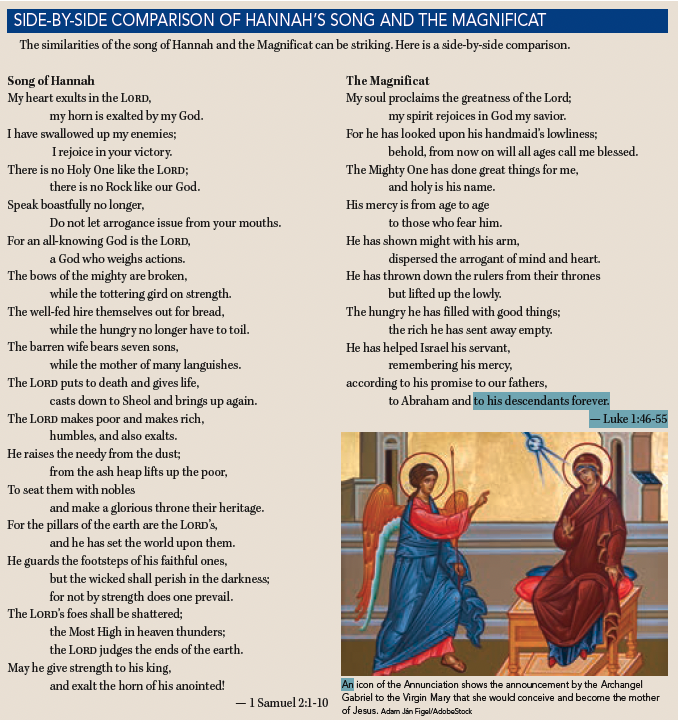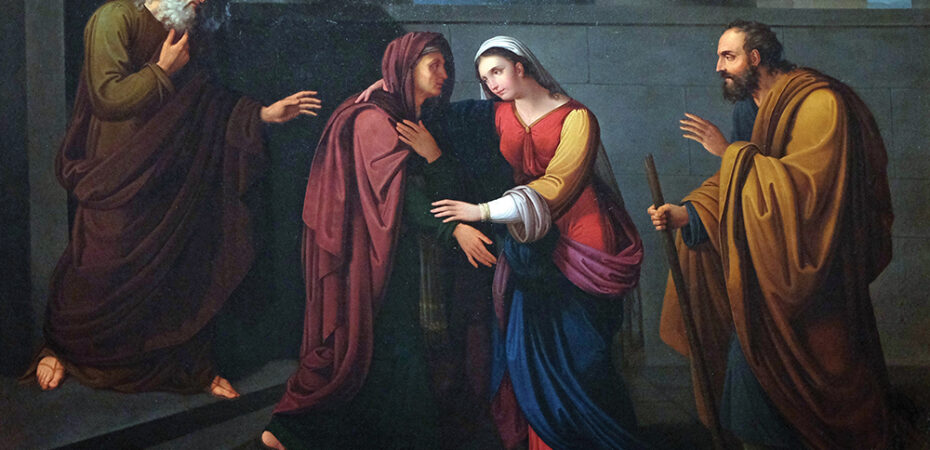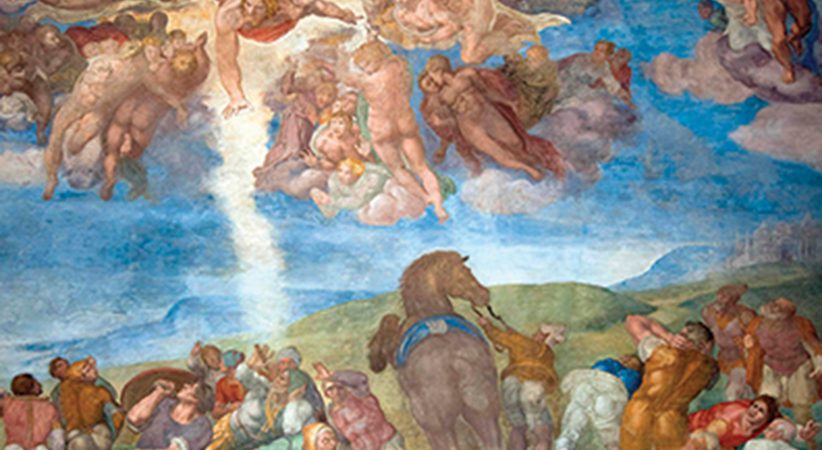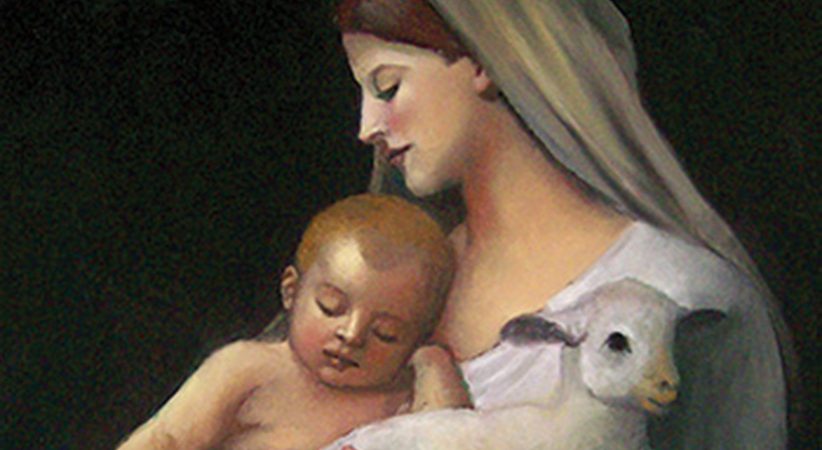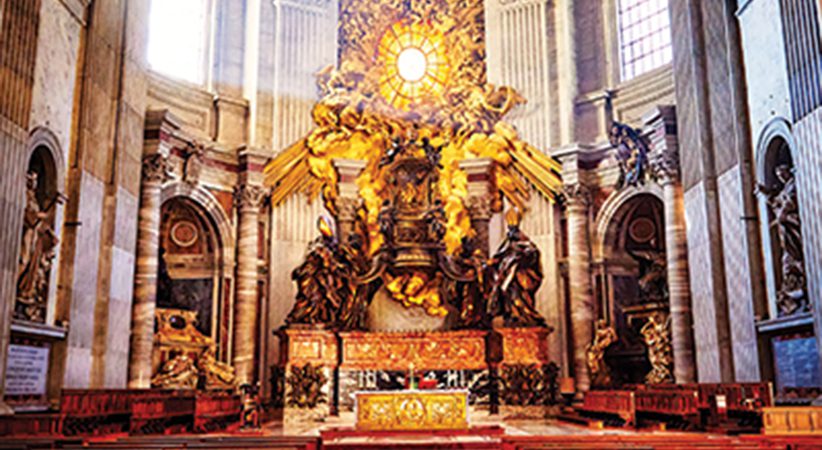A Visit Beyond All Visits
Father Eugene Hensell Comments Off on A Visit Beyond All Visits
When is a visit more than simply the action of going to see someone for social reasons or friendship? When it involves two women both on a mission from God. Both are pregnant and both are carrying infants who together will change the shape of the world for centuries to come.
The visit that Mary pays to Elizabeth is far more about theology than history. It begins with two previous visits described by Luke. The first visit was when the archangel Gabriel surprised the priest Zechariah right in the middle of the Temple incense service (cf. Lk 1:5-25). The second visit involved the archangel Gabriel again, but this time with an appearance to Mary in the village of Nazareth (Lk 1:26-38).
It is important to see how Luke has constructed these two visitations. It is as if he divided his parchment into two halves. On the left side is the story about the angel Gabriel and Zechariah. On the right side of the parchment is the story about Gabriel and Mary. Luke adopts this structure so that the reader (or listener) can easily compare one story with the other. While everything involving Gabriel, Zechariah and John the Baptist is grace-filled and quite significant, everything involving Gabriel, Mary and Jesus is far more significant and fulfilling.
Behind all of this is a challenge with which all the Gospel writers were confronted — that is, a correct understanding of the role of John the Baptist in relation to the life and ministry of Jesus. John the Baptist had a specific mission, which was to prepare the way for the coming Messiah. However, some found John the Baptist more attractive as a messiah candidate than Jesus. Part of the function of the story of the Visitation is to show John the Baptist as subordinate to Jesus. Let us take a closer look at the Visitation story.
Prophetic Gesture
Mary already knows that her relative Elizabeth is pregnant. Gabriel informed her of this during his annunciation to Mary (cf. Lk 1:36). Since it was also known that Elizabeth had been barren for years, this miraculous turn of events might be the motive for Mary’s visit. That is mostly speculation. We are also told that Mary undertook this journey with haste. But again, we are not told why she seems to be in such a hurry.
Upon arrival, however, Mary’s first action is to greet Elizabeth. From the very beginning, this greeting has prophetic overtones. The focus quickly switches from the two women to the infants they are carrying. Elizabeth’s unborn child immediately leaps in her womb upon hearing Mary’s voice.
This is a prophetic action on the part of the yet-to-be-born John the Baptist. Elizabeth herself follows this prophetic gesture with a prophetic oracle of her own. First, however, she is filled with the Holy Spirit. In Luke’s Gospel, most of the characters having speaking roles first are filled with the Holy Spirit. Therefore, the words she proclaims are not her own. They are the words of God mediated through Elizabeth. This prophetic oracle is actually aimed at describing Mary. She is the one declared blessed among women. But more important yet is the child in her womb, the unborn Jesus.
Having declared the blessedness of Mary and the infant she is carrying in her womb, Elizabeth expresses more than a little puzzlement and surprise that this should happen to her. Her bewilderment is that a woman higher in status (Mary) comes to one who is lower in status (Elizabeth).
By pronouncing a blessing on Mary, Elizabeth assumes the posture of one higher in status yet she does so only to give Mary the higher honor. While such role reversals might not seem important to our contemporary culture, they were extremely important in the culture of first-century Palestine. Here there is even more to observe.
Note that in a social world that places little stake in what women have to say (first-century Palestine), this narrative hinges on an encounter between two women and on the words they exchange. Both women speak with a prophetic voice. Elizabeth provides meaning to the gesture that factually begins John the Baptist’s prophetic mission. Ultimately, however, it will be the sons these women carry inside them who will be prophet and Messiah, agents of divine deliverance for Israel and for the nations.
Elizabeth, in her role as prophet, proclaims the final beatitude of this particular visitation experience. She declares Mary blessed because she has had the courage and faith to believe that what was spoken to her by the Lord would be fulfilled. This, of course, is a reference to the archangel Gabriel’s annunciation in Luke 1:26-38. Mary was not given all the details of how this would unfold, but nevertheless she responded with trusting acceptance. She was reminded by the archangel Gabriel that nothing is impossible with God. Mary’s visit to Elizabeth is an expression of that faith. In fact, it is not an overstatement to say faith permeates this whole event.
Two Story Lines
Two separate story lines merge when Mary visits Elizabeth. Two annunciation stories are transformed into prophecy. Two very important prophetic oracles stem from the account of this visitation.
The first comes from Elizabeth and focuses on the importance of Mary (cf. Lk 1:42-45). The second prophetic oracle comes from Mary and follows immediately (vv. 46-55). Here the focus is on Jesus and the grand reversals he will enact in and through his mission. This oracle is often referred to as the Magnificat, from the first word of the Latin Vulgate translation. Structurally, this oracle was not originally part of the story. It was most likely an ancient Christian hymn that Luke discovered.
Scholars think that this hymn was influenced by the hymn Hannah proclaimed at the birth of her son, Samuel (cf. 1 Sm 2:1-10). Once again, we have a hymn of praise directed to God for fulfilling Hannah’s desire to have a child after years of barrenness. Similar themes can be found in both the song of Hannah and Mary’s Magnificat. The attraction of the hymn was that it contained many of the themes found throughout Luke’s Gospel. In this case, Luke found it a suitable text to attach to the history of the Visitation.
We need to recall the importance of hymns in the Bible, both in the Old Testament and the New Testament. Hymns represent the earliest articulations of faith in biblical tradition. Believers expressed their faith through song, and these songs are what today we call hymns. An interesting aspect of the Magnificat is that a few ancient and reliable manuscripts have it coming from Elizabeth rather than Mary. If read from the perspective of Elizabeth, the hymn makes good sense.
Scholars generally leave it attached to Mary since that also has a long manuscript tradition. Attributing the hymn to Mary serves as a balance to the prophetic oracle uttered by Elizabeth back in Luke 1:42-45. It also serves as an epilogue to the whole Visitation story.
Mary’s Magnificat
Keep in mind Luke’s method of comparing Jesus to John the Baptist throughout the infancy narrative. Here again, the Magnificat comes from Mary and shows the grand reversals that eventually will transpire through Jesus. It begins with Mary expressing joy over the greatness of the Lord for all that he has done for her. He has used her lowliness to accomplish great things.
Remember how this is similar to what Elizabeth proclaimed about Mary in her oracle (cf. Lk 1:42-45). Mary does not spend much time talking about herself in this prophetic oracle. Her purpose is to disclose what can be expected from her son once he matures. The Mighty One is characterized by mercy which extends throughout the ages to all who fear him.
At this point, the oracle begins to focus on the divine reversals that Mary’s son will institute. A major theme here is the triumph of the oppressed. Rulers will be dethroned while the lowly will be lifted up. The hungry will be fed and the rich sent away empty. All of this is understood to be promises made by God that will be fulfilled in and through God’s Son. Of course, one of Luke’s main themes is that God always keeps the promises God makes.
More About Theology Than History
At the beginning of this reflection, we admitted that the story of Mary visiting Elizabeth was more about theology than history. Let’s further explore that. Thus far we have looked at three visitation stories, all unique to Luke’s Gospel.
In capsule form: The first describes the archangel Gabriel visiting Zechariah to announce the good news about Elizabeth and the child she will bear (cf. Lk 1:5-25). The second involves the archangel Gabriel announcing to Mary the remarkable events that are going to transpire in her life as she conceives a child who will be the Son of the Most High (Lk 1:26-38). The third, and the one we have been most interested in, takes place when Mary, pregnant with Jesus, hastens to visit Elizabeth, pregnant with John the Baptist (Lk 1:39-45).
………………………………………………………………………………………………………………………………………
The Messages of Gabriel
Gabriel announced the birth of John to Zechariah in Luke 1:11-23, and the birth of Jesus in Luke 1:26-38. First is the story of Gabriel’s visit with Zechariah and then Gabriel’s visit with Mary.
Gabriel visits Zechariah
Luke 1:11-23: The angel of the Lord appeared to him, standing at the right of the altar of incense. Zechariah was troubled by what he saw, and fear came upon him. But the angel said to him, “Do not be afraid, Zechariah, because your prayer has been heard. Your wife Elizabeth will bear you a son, and you shall name him John. And you will have joy and gladness, and many will rejoice at his birth, / for he will be great in the sight of [the] Lord. He will drink neither wine nor strong drink. He will be filled with the holy Spirit even from his mother’s womb, and he will turn many of the children of Israel to the Lord their God. He will go before him in the spirit and power of Elijah to turn the hearts of fathers toward children and the disobedient to the understanding of the righteous, to prepare a people fit for the Lord.” Then Zechariah said to the angel, “How shall I know this? For I am an old man, and my wife is advanced in years.” And the angel said to him in reply, “I am Gabriel, who stand before God. I was sent to speak to you and to announce to you this good news. But now you will be speechless and unable to talk until the day these things take place, because you did not believe my words, which will be fulfilled at their proper time.” Meanwhile the people were waiting for Zechariah and were amazed that he stayed so long in the sanctuary. But when he came out, he was unable to speak to them, and they realized that he had seen a vision in the sanctuary. He was gesturing to them but remained mute. Then, when his days of ministry were completed, he went home.— Luke 1:11-23
Gabriel visits Mary
Luke 1:26-38: In the sixth month, the angel Gabriel was sent from God to a town of Galilee called Nazareth, to a virgin betrothed to a man named Joseph, of the house of David, and the virgin’s name was Mary. And coming to her, he said, “Hail, favored one! The Lord is with you.” But she was greatly troubled at what was said and pondered what sort of greeting this might be. Then the angel said to her, “Do not be afraid, Mary, for you have found favor with God. Behold, you will conceive in your womb and bear a son, and you shall name him Jesus. He will be great and will be called Son of the Most High, and the Lord God will give him the throne of David his father, and he will rule over the house of Jacob forever, and of his kingdom there will be no end.” But Mary said to the angel, “How can this be, since I have no relations with a man?” And the angel said to her in reply, “The holy Spirit will come upon you, and the power of the Most High will overshadow you. Therefore the child to be born will be called holy, the Son of God. And behold, Elizabeth, your relative, has also conceived a son in her old age, and this is the sixth month for her who was called barren; or nothing will be impossible for God.” Mary said, “Behold, I am the handmaid of the Lord. May it be done to me according to your word.” Then the angel departed from her. — Luke 1:26-38
…………………………………………………………………………………………………………………………………………..
Luke has yet another visitation story, which we have not considered. Once again it is unique to him and involves Jesus raising up the dead son of the widow of Nain (cf. Lk 7:11-17). The initial response of the people to this miraculous action of Jesus is fear, which quickly transforms into glorification. That glorification is expressed this way: “‘A great prophet has arisen in our midst,’ and ‘God has visited his people’” (Lk 7:16).
Here, Jesus is the great prophet and his prophetic action is the raising of the widow’s dead son. This prophetic action is again declared a visitation. For Luke, prophesy is at the heart of visitation. Every visitation is some form of prophetic action. Each visitation carries with it a divine message that gets communicated through some form of prophetic activity. Gabriel, Mary, Elizabeth and Jesus all communicate divine revelation through prophetic action. For Luke, those prophetic actions take the form of a visitation.
Connection to Priesthood
Does anything in this reflection on the Visitation have any relevance to our contemporary priestly ministry? Many priests, young and old, when asked what, in addition to the sacraments, gives them the greatest joy in their ministry, will say visiting the parishioners. On the other hand, one of the biggest complaints also expressed by these same priests is the lack of time to do parish visitations. That is a plague affecting most priests. Still, it is a value we should strive to maintain.
Visitations in today’s ministry can take a variety of forms. Communion calls, shut-ins, the sick and those in hospitals, and the elderly and infirmed in nursing homes, are but a few of the more traditional modes of visitation. Always, they are more than just social calls. This becomes apparent immediately as those visited express their deep appreciation for the presence of the priest. These visitations are understood as moments of grace.
Let me suggest that such visitations are also prophetic actions. They mediate the presence of God in the form of a visit. In many ways, this is the same understanding expressed by Luke in the four visitations unique to his Gospel. This might give us cause to think a bit more creatively about parish visits. They are not merely pastoral duties, they are also prophetic actions.
FATHER EUGENE HENSELL, OSB, is a monk of St. Meinrad Archabbey in St. Meinrad, Indiana, and an associate professor of Scripture at St. Meinrad Seminary and School of Theology.
